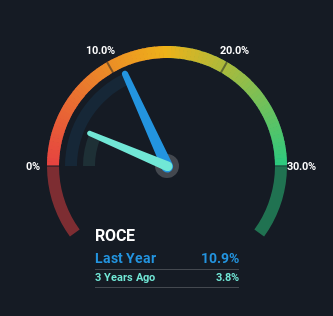- United States
- /
- Healthcare Services
- /
- NasdaqGS:ACHC
We Like These Underlying Return On Capital Trends At Acadia Healthcare Company (NASDAQ:ACHC)
What are the early trends we should look for to identify a stock that could multiply in value over the long term? In a perfect world, we'd like to see a company investing more capital into its business and ideally the returns earned from that capital are also increasing. If you see this, it typically means it's a company with a great business model and plenty of profitable reinvestment opportunities. Speaking of which, we noticed some great changes in Acadia Healthcare Company's (NASDAQ:ACHC) returns on capital, so let's have a look.
What Is Return On Capital Employed (ROCE)?
If you haven't worked with ROCE before, it measures the 'return' (pre-tax profit) a company generates from capital employed in its business. To calculate this metric for Acadia Healthcare Company, this is the formula:
Return on Capital Employed = Earnings Before Interest and Tax (EBIT) ÷ (Total Assets - Current Liabilities)
0.11 = US$489m ÷ (US$5.3b - US$865m) (Based on the trailing twelve months to September 2023).
Therefore, Acadia Healthcare Company has an ROCE of 11%. That's a relatively normal return on capital, and it's around the 9.9% generated by the Healthcare industry.
Check out our latest analysis for Acadia Healthcare Company

In the above chart we have measured Acadia Healthcare Company's prior ROCE against its prior performance, but the future is arguably more important. If you'd like, you can check out the forecasts from the analysts covering Acadia Healthcare Company here for free.
What Can We Tell From Acadia Healthcare Company's ROCE Trend?
Acadia Healthcare Company has not disappointed in regards to ROCE growth. The figures show that over the last five years, returns on capital have grown by 55%. The company is now earning US$0.1 per dollar of capital employed. In regards to capital employed, Acadia Healthcare Company appears to been achieving more with less, since the business is using 27% less capital to run its operation. A business that's shrinking its asset base like this isn't usually typical of a soon to be multi-bagger company.
On a side note, we noticed that the improvement in ROCE appears to be partly fueled by an increase in current liabilities. Essentially the business now has suppliers or short-term creditors funding about 16% of its operations, which isn't ideal. It's worth keeping an eye on this because as the percentage of current liabilities to total assets increases, some aspects of risk also increase.
The Key Takeaway
From what we've seen above, Acadia Healthcare Company has managed to increase it's returns on capital all the while reducing it's capital base. Since the stock has returned a staggering 138% to shareholders over the last five years, it looks like investors are recognizing these changes. So given the stock has proven it has promising trends, it's worth researching the company further to see if these trends are likely to persist.
On a separate note, we've found 2 warning signs for Acadia Healthcare Company you'll probably want to know about.
For those who like to invest in solid companies, check out this free list of companies with solid balance sheets and high returns on equity.
New: Manage All Your Stock Portfolios in One Place
We've created the ultimate portfolio companion for stock investors, and it's free.
• Connect an unlimited number of Portfolios and see your total in one currency
• Be alerted to new Warning Signs or Risks via email or mobile
• Track the Fair Value of your stocks
Have feedback on this article? Concerned about the content? Get in touch with us directly. Alternatively, email editorial-team (at) simplywallst.com.
This article by Simply Wall St is general in nature. We provide commentary based on historical data and analyst forecasts only using an unbiased methodology and our articles are not intended to be financial advice. It does not constitute a recommendation to buy or sell any stock, and does not take account of your objectives, or your financial situation. We aim to bring you long-term focused analysis driven by fundamental data. Note that our analysis may not factor in the latest price-sensitive company announcements or qualitative material. Simply Wall St has no position in any stocks mentioned.
About NasdaqGS:ACHC
Acadia Healthcare Company
Provides behavioral healthcare services in the United States and Puerto Rico.
Undervalued with moderate growth potential.
Similar Companies
Market Insights
Community Narratives



